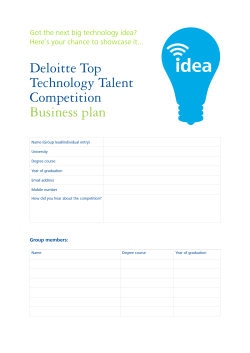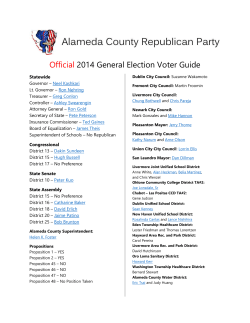
BUSINESS MODELLING 2013-1-ES1-LEO05-67282
BUSINESS MODELLING 2013-1-ES1-LEO05-67282 Purpose of business modelling To identify a combination of values represented by the products, d t processes, services i for f the th targeted t t d customers and consumers the method of creating and delivering this value the way how to persuade customers and consumers to pay for this value the mechanism how to convert these payments into profit Objective of a business model To develop an attractive offer for customers/consumers based on a bundle of products, services, related value added services which hi h can be b delivered d li d in i a profitable fit bl way Scope of application Products, processes, services, systems and market concepts of food businesses which are based on commercialisation of R+D+I results and activities The business model canvas 7. Key partnerships KP 6. Key Activities KA 5. Key Resources KR 1. Value Propositions VP 9. Cost structure C$ Forrás: Business Model Canvas (Osterwalder, Pigneur 2010.) 4. Customer RelationRelation ships CR 2. Customer Segments CS 3. Channels CH 8. Revenue Streams RS Development of a business model Consider C id aspects t represented t d by b the th building b ildi 9 blocks Be specific for your business idea, consumer/customer segment, internal and external resources, business environment, business culture Record R d your fi findings di for f eachh building b ildi blocks bl k in i Template 1 4.1 Core value propositions Main aggregated benefits offered to a specific customer/consumer segment through a bundle off products and/or / related services What we offer for them what they see as a valuable solution for one of their problems? What is the p problem or what is the new need,, which has not been served yet? Are they ready to pay for it? Why they should choose our offer compared to other competitive offers? Template 1 Typical elements, for creating values to a specific customer/consumer / segment Newness,, novelty y Better performance Customisation of products and services to specific needs of customers/consumers or their segment Provision of related services Attractive design Brand and the status represented by it Price Enabling E bli costt reduction d ti Risk reduction Accessibility A Convenience/Usability 4.2 Identify customer segments (1) Customer/consumer segment: a distinct group having common needs, expectations, behaviour or other attributes whom we want to reach – who are most likely to be attracted by our value proposition 4.2 Identify customer segments (2) C id similarities Consider i il iti and d differences diff in i needs product d and d service i attributes ib seen as a value l preferred distribution channels expectations i and d requirements i for f relationships l i hi with ih the product/service provider buying b i power willingness to pay for different elements of the offer, ff etc. other potential grouping criteria Typical types of customer segments IIn addition dditi tto specific ifi character h t off th the customer/consumer group Mass market N Niche market Slightly segmented, slightly differing Diversified Multi-sided platform (or multi-sided markets) representing i a situation i i where h two or more interdependent customer segments are served 4.3 Establish distribution channels How the users can access to the products and services? How we communicate – with our customers and consumers? Define, which channels cover the following functions: Raising awareness among customers/consumers about your products and services p Helping customers/consumers to evaluate your value proposition(s) Allowing your customers/consumers to purchase your specific products and services Making your value proposition based on your products and services and their combination available to your customers/consumers Providing post-purchase support Mixing several channels may be necessary Potential distribution channels Own O Partners channels Consider number of contacts profit margin cost efficiency financial risks 4.4 Determine customer relationships (1) How customers/consumers H t / will ill be b attracted tt t d and d retained Define your aim in the segment Acquire new customers/ consumers (usually through marketing) Retain existing customers/ consumers (usually through services) i ) Add-on selling (increase the purchase of the existing customers/consumers) (usually through sales) customers/consumers), 4.4 Determine customer relationships (2) Define, what your customers/consumers expect in Define relationships What yyou p provide now and what has to be added? Consider typical types of customer relationships: Personal assistance Dedicated personal assistance Self- service Automated A d service i User communities (including online ones) Co-creation Co creation by involving customers into the development process Adjustment to personal needs Etc. 4.5 Specify key resources, capabilities and core competencies (1) Which resources, resources capabilities and competencies are necessary to create and offer value proposition reach markets main customer relationships earn revenues in your customer/consumer segment? 4.5 Specify key resources, capabilities and core competencies (2) D Describe ib your main i resources, capabilities competences Define your core competence Define, which resources, capabilities and competences can you access from f your chain h i partners (customers/consumers) ( / ) 4.6 Define key activities to create and offer value propositions (1) Which key activities are required to create and offer our value propositions reach markets maintain relationships with our customer/consumer segment earn revenues Analyse and evaluate Inbound logistics (purchasing (purchasing, receiving receiving, warehousing warehousing, inventory control of input – raw material, ingredients, additives, packaging material, other resources- materials; 4.6 Define key activities to create and offer value propositions (2) Production (designing (designing, preparation preparation, manufacturing manufacturing, delivering a product in required quantity and quality by the required deadline)) Problem solving (developing new solutions for individual customer problems, knowledge management, regular training) Outbound O b d logistics l (warehousing, ( h order d fulfilment, f lf l transport, etc.) Platform/network (establishing and maintaining matchmaking platforms or network- related activities) Marketing and sale (channel selection, advertising, pricing, etc.) After-sale (customer support, repair services, etc.) 4.7 Identify key partnership With whom is necessary to collaborate systematically? Who are our strategic partners, alliances for providing our value proposition What are the motivators of these partnerships? with non-competitors p with competitors joint ventures buyer-supplier buyer supplier relationships optimisation economy of scales reduction of risks and uncertainty acquisition q of complementary/additional p y/ resources,, capabilities, p , competences from your chain partners – what? from whom? Who are your suppliers? 4.8 Establish revenue streams (1) D fi hhow we will Define ill generate t revenue?? For which value are our customers/consumers in the targeted segment really willing to pay? Describe the answers for each segment Evaluate several options for getting revenue For which value are paying your customers/consumers now? How they prefer to pay? 4.8 Establish revenue streams (2) Consider One time payments Revenues from on-going repeated payments Post purchase customer support 4.8 Establish revenue streams (3) Consider typical ways to generate revenue: Asset sale; Usage fee; fee Subscription fee; Lending/Renting/Leasing; L di /R ti /L i Licensing, Maintenance M i and d updating d i fee f for f softwares, f b books k and d other h knowledge based products; Maintenance service fee for machinery; machinery Refilling 4.9 Define cost structure (1) H our costs are calculated, How l l d allocated ll d and d covered? d? creating, marketing and offering value reaching markets using resources, resources assets, assets carrying out activities maintaining customer/consumer relationships and partner network p relationship earing revenues Which costs structure is most appropriate for our approach? cost driven, which focuses on minimising costs value driven, which focuses on value creation 4.9 Define cost structure (2) Analyse fixed costs, variable costs cost advantages through economies of scale and economies of scope 26 4.10 Design your business model Be fl B flexible ibl and d creative ti The listed options within the building blocks are typical examples l only. l Y You are free f to t create t new w concepts, t approaches and tools. 4.11 Use your business model as an input to thee bus business ess sstrategy a egy In summary Business model Scope of application Th b The business i model d l canvas Development of a business model (typical elements)
© Copyright 2025





















